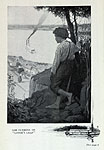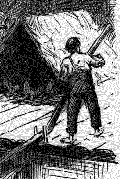



| Paine was MT's Boswell, the biographer who lived with the author during the last years of his life collecting impressions and material for the 4-volume study he published in 1912, two years after MT's death . Four years later he brought out this heavily illustrated "boys' biography." It includes a chapter comparing the mischevious adventures of the young Sam Clemens to Tom's Sawyer's escapades, but in the excerpts below, describing the world of Clemens' childhood, he makes Hannibal look at least as much like the gritty villages we see through Huck Finn's eyes as like Tom Sawyer's enticing playground. |
|
|
|||

|

|

|

|
|
HANNIBAL was a town with prospects and considerable trade. It was slumbrous, being a slave town, but it was not dead. John Clemens believed it a promising place for business, and opened a small general store with Orion Clemens, now fifteen, a studious, dreamy lad, for clerk. The little city was also an attractive place of residence. Mark Twain remembered it as "the white town drowsing in the sunshine of a summer morning, . . . the great Mississippi, the magnificent Mississippi, rolling its mile-wide tide along, . . . the dense forest away on the other side." The "white town" was built against green hills, and abutting the river were bluffs--Holliday's Hill and Lover's Leap. A distance below the town was a cave--a wondrous cave, as every reader of Tom Sawyer knows--while out in the river, toward the Illinois shore, was the delectable island that was one day to be the meeting-place of Tom's pirate band, and later to become the hiding-place of Huck and Nigger Jim. The river itself was full of interest. It was the highway to the outside world. Rafts drifted by; smartly painted steamboats panted up and down, touching to exchange traffic and travelers, a never-ceasing wonder to those simple shut-in dwellers whom the telegraph and railway had not yet reached. That Hannibal was a pleasant place of residence we may believe, and what an attractive place for a boy to grow up in! . . . He had learned a great deal of natural history and botany--the habits of plants, insects, and animals. Mark Twain's books bear evidence of this early study. His plants, bugs, and animals never do the wrong things. He was learning a good deal about men, and this was often less pleasant knowledge. Once Little Sam--he was still Little Sam then--saw an old man shot down on Main Street at noon-day. . . . He saw a young emigrant stabbed with a bowie-knife by a drunken comrade, and two young men try to kill their uncle, one holding him while the other snapped repeatedly an Allen revolver, which failed to go off. Then there was the drunken rowdy who proposed to raid the "Welshman's" house, one sultry, threatening evening--he saw that, too. . . . That was a day and locality of violent impulse and sudden action. Happenings such as these were not infrequent in a town like Hannibal. And there were events connected with slavery. Sam once saw a slave struck down and killed with a piece of slag, for a trifling offense. He saw an Abolitionist attacked by a mob that would have lynched him had not a Methodist minister defended him on a plea that he must be crazy. He did not remember in later years that he had ever seen a slave auction, but he added: "I am suspicious that it was because the thing was a commonplace spectacle and not an uncommon or impressive one. I do vividly remember seeing a dozen black men and women, chained together, lying in a group on the pavement, waiting shipment to a Southern slave-market. They had the saddest faces I ever saw." |

